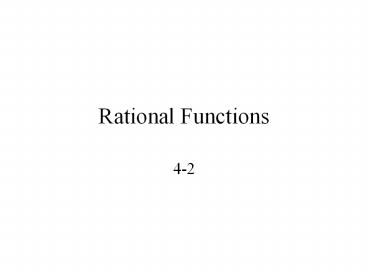Rational Functions - PowerPoint PPT Presentation
1 / 31
Title:
Rational Functions
Description:
Rational Functions 4-2 – PowerPoint PPT presentation
Number of Views:798
Avg rating:3.0/5.0
Title: Rational Functions
1
Rational Functions
- 4-2
2
A Rational Function is an equation in the form of
f(x) p(x)/q(x), where p(x) and q(x) are
polynomial functions, and q(x) does not equal
zero.
3
The parent rational function is f(x) . Its
graph is a hyperbola, which has two separate
branches.
4
(No Transcript)
5
(No Transcript)
6
Using the graph of f(x) as a guide,
describe the transformation and graph each
function.
A. g(x)
B. g(x)
Because h 2, translate f 2 units left.
Because k 3, translate f 3 units down.
7
(No Transcript)
8
Identify the zeros and vertical asymptotes of
f(x) .
Step 1 Find the zeros and vertical asymptotes.
Factor the numerator.
The numerator is 0 when x 4 or x 1.
Zeros 4 and 1
The denominator is 0 when x 3.
Vertical asymptote x 3
9
Identify the zeros and vertical asymptotes of
f(x) .
Step 1 Find the zeros and vertical asymptotes.
Factor the numerator.
The numerator is 0 when x 6 or x 1 .
Zeros 6 and 1
The denominator is 0 when x 3.
Vertical asymptote x 3
10
Some rational functions, including those whose
graphs are hyperbolas, have a horizontal
asymptote. The existence and location of a
horizontal asymptote depends on the degrees of
the polynomials that make up the rational
function.
Note that the graph of a rational function can
sometimes cross a horizontal asymptote. However,
the graph will approach the asymptote when x is
large.
11
To find Horizontal Asymptotes, compare the
degrees of the numerator and the denominator. (3
scenarios)
Since degree of numerator is less than the degree
of the denominator A horizontal asymptote occurs
at y 0
Since degrees of the numerator and denominator
are equal, divide the coefficients of the highest
degree terms. A horizontal asymptote occurs at y
9/5
Since the degree of numerator is larger than the
degree of the denominator No horizontal
asymptote
12
Identify the zeros and asymptotes of the
function. Then graph.
Factor the denominator.
The numerator is 0 when x 2.
Zero 2
The denominator is 0 when x 1.
Vertical asymptote x 1, x 1
Horizontal asymptote y 0
Degree of p lt degree of q.
13
Identify the zeros and asymptotes of the
function. Then graph.
Graph with a graphing calculator or by using a
table of values.
14
Identify the zeros and asymptotes of the
function. Then graph.
Factor the numerator.
The numerator is 0 when x 3.
Zero 3
The denominator is 0 when x 1.
Vertical asymptote x 1
Horizontal asymptote y 4
15
Identify the zeros and asymptotes of the
function. Then graph.
Graph with a graphing calculator or by using a
table of values.
16
Identify the zeros and asymptotes of the
function. Then graph.
f(x)
Factor the numerator.
The numerator is 0 when x 3 or x 5.
Zeros 3 and 5
The denominator is 0 when x 1.
Vertical asymptote x 1
Horizontal asymptote none
Degree of p gt degree of q.
17
A Hole occurs at x a whenever there is a common
factor (x a) in the numerator and denominator
of the function. Example of a function with a
hole
18
Factor the numerator.
There is a hole in the graph at x 3.
The expression x 3 is a factor of both the
numerator and the denominator.
Divide out common factors.
19
The graph of f is the same as the graph of y x
3, except for the hole at x 3. On the graph,
indicate the hole with an open circle. The domain
of f is xx ? 3.
20
Factor the numerator.
There is a hole in the graph at x 2.
The expression x 2 is a factor of both the
numerator and the denominator.
Divide out common factors.
21
The graph of f is the same as the graph of y x
3, except for the hole at x 2. On the graph,
indicate the hole with an open circle. The domain
of f is xx ? 2.
22
1. Using the graph of f(x) as a guide,
describe the transformation and graph the
function g(x) .
g is f translated 4 units right.
2.
asymptotes x 1, y 2 Dxx ? 1 Ryy ?
2
23
3. Identify the zeros, asymptotes, and holes in
the graph of . Then
graph.
zero 2 asymptotes x 0, y 1 hole at x 1
24
- Example Create a function of the form y f(x)
that satisfies the given set of conditions - Vertical asymptote at x 2, hole at x -3
25
If we were looking for horizontal asymptotes, we
would use scenario 3 where the degree of the
numerator is greater than the degree of the
denominator, and therefore no horizontal
asymptote.
However, when the degree of the numerator is
exactly one greater than the degree of the
denominator it is possible that there is a
Oblique or Slant ASYMPTOTE.
26
Find the equation of the slant asymptote for the
function .
Use polynomial long division
What happens as
So the slant asymptote is the line
27
To determine the equation of the oblique
asymptote, divide the numerator by the
denominator,( use polynomial long division or
synthetic division) and then see what happens as
The equation of the slant asymptote for this
example is y x.
28
Example Determine the slant asymptote for the
following function
29
(No Transcript)
30
5-Minute Check Lesson 3-8A
31
5-Minute Check Lesson 3-8B































